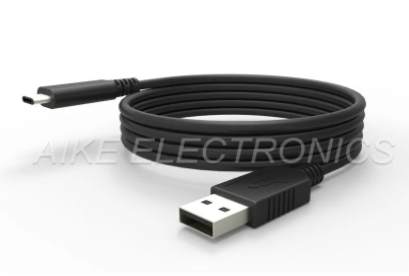What's the Maximum Length for USB Cables?
Introduction
In the modern world, where devices and gadgets have become an integral part of our daily lives, USB cables have become lifelines connecting our digital universe. Among these, USB Type-C (USB-C) cables stand out for their versatility, speed, and reversibility. However, as we delve into the intricacies of USB-C cables, a pertinent question arises: what is the maximum length for USB-C cables? In this article, we'll unravel the technical considerations, limitations, and best practices associated with USB-C cable length.
Understanding USB-C: A Brief Overview
USB-C is a universal connectivity standard that has revolutionized the way we interact with our devices. It offers higher data transfer rates, greater power delivery capabilities, and a reversible connector that eliminates the frustration of trying to plug it in the right way.
USB-C cables consist of multiple wires, each with its specific purpose: power delivery, data transfer, and grounding. While these cables are known for their impressive performance, they are not exempt from limitations, including length restrictions.
The Maximum Cable Length Dilemma
Unlike its predecessors, USB-C cables have more complex circuitry due to their multifunctional nature. This complexity brings both benefits and challenges. One of these challenges is the limitation on cable length. The primary factor that determines the maximum length of a USB-C cable is signal integrity, which refers to the preservation of the quality of signals along the length of the cable.
As a rule of thumb, shorter cables tend to have better signal integrity compared to longer ones. When a USB-C cable exceeds its maximum length, issues such as signal degradation, data loss, and reduced charging efficiency can arise. Thus, striking a balance between cable length and performance is crucial.
USB-C Cable Categories
To better understand the limitations of USB-C cable length, it's essential to recognize the different categories of USB-C cables, each designed for specific purposes. These categories are:
Gen 1 (USB 3.0): These cables support data transfer rates of up to 5 Gbps (gigabits per second).
Gen 2 (USB 3.1): Gen 2 cables offer faster data transfer rates of up to 10 Gbps.
Gen 2x2 (USB 3.2): These cables provide even higher data transfer rates, reaching up to 20 Gbps.
Thunderbolt 3: Thunderbolt 3 cables are a subset of USB-C cables but offer significantly higher data transfer rates of up to 40 Gbps and support various peripherals, including external displays.
How Do Deep Cycle Battery packs Work?
What are Types and Applications of Lithium Batteries?
Small Size, Big Impact: How Micro Camera Modules Are Changing Industries
Choosing and Installing PE Cable Threading Pipe
How Does the Electric Blanket Controller Work?
What happens when a PTC is heated?
LED video walls
The length limitations of these cables vary due to differences in their internal design and the protocols they support.
Maximum Length Guidelines
While the maximum length of USB-C cables can vary depending on factors such as cable quality and shielding, certain general guidelines can help you choose the right cable length for your needs:
Gen 1 and Gen 2 Cables (USB 3.0 and 3.1): For Gen 1 and Gen 2 cables, it's generally recommended to keep the cable length within 3 meters (approximately 9.8 feet) to maintain optimal signal integrity and performance. Longer cables might experience signal degradation and reduced data transfer rates.
Gen 2x2 Cables (USB 3.2): Gen 2x2 cables, which support higher data transfer rates, may have a slightly shorter recommended length of around 1-2 meters (approximately 3.3-6.6 feet).
Thunderbolt 3 Cables: Thunderbolt 3 cables, capable of handling the highest data transfer rates, usually have a maximum recommended length of around 0.5 meters (approximately 1.6 feet) to 2 meters (approximately 6.6 feet).
It's important to note that the above guidelines are not rigid rules but rather general recommendations to ensure the best possible performance. Factors such as cable quality, manufacturing standards, and the specific use case can influence the actual performance of a USB-C cable beyond these guidelines.
Extending USB-C Cable Length: Best Practices
If your specific needs require longer cable lengths, there are some practices you can follow to mitigate signal degradation:
Use Active Cables: Active cables incorporate built-in signal boosters to counteract signal loss over longer distances. These cables can provide better performance compared to passive cables.
Quality Matters: Invest in high-quality USB-C cables from reputable manufacturers. These cables are more likely to have proper shielding and construction that can help maintain signal integrity.
Avoid Daisy-Chaining: Daisy-chaining multiple cables together can increase the risk of signal loss. Whenever possible, use a single, continuous cable for the best performance.
Keep It Straight: Minimize sharp bends or twists in the cable, as these can impact signal quality. Using cable organizers or clips to secure the cable without bending it excessively is recommended.
Conclusion
USB-C cables have ushered in an era of enhanced connectivity, speed, and versatility. While their performance is remarkable, it's essential to respect the maximum cable length guidelines to ensure optimal signal integrity and data transfer rates. By understanding the limitations of USB-C cables and implementing best practices, you can strike the right balance between cable length and performance, ensuring that your digital experiences remain seamless and efficient, no matter the distance between your devices.
What Led walls are used for and how they work
How does an Automotive Agm Start-Stop Battery differ from a traditional battery?
Differences Between An LED Display And LCD Monitor
Are Compact Substations the Ideal Choice for Large-Scale Power Distribution Projects?
What is surface mount technology (SMT)?
7 Things You Should Know About Outdoor LED Billboards




